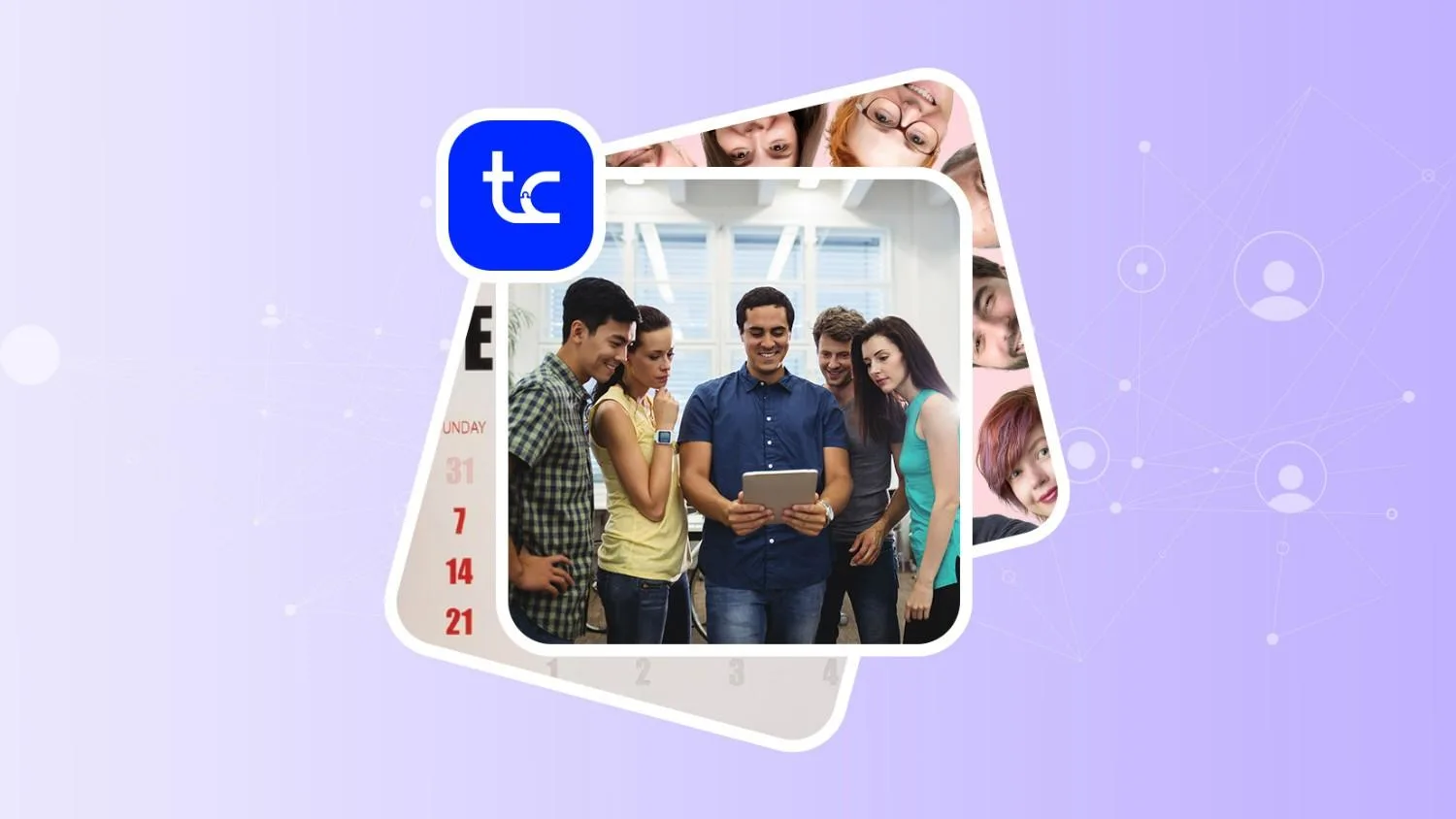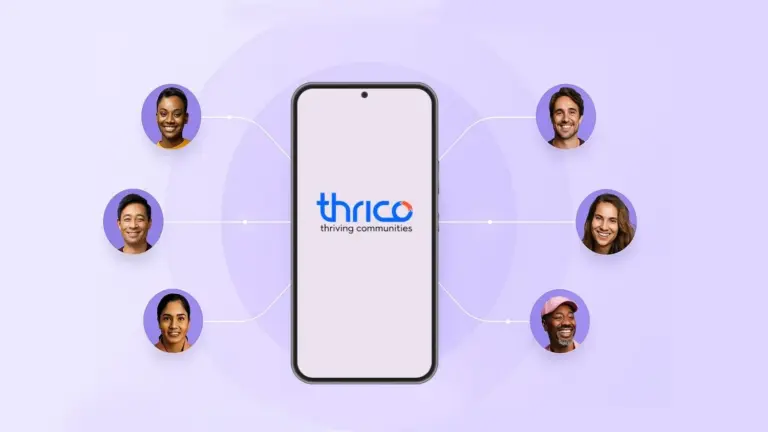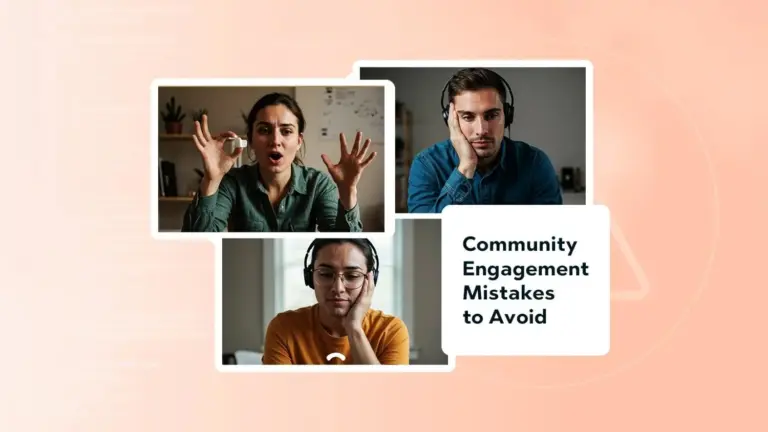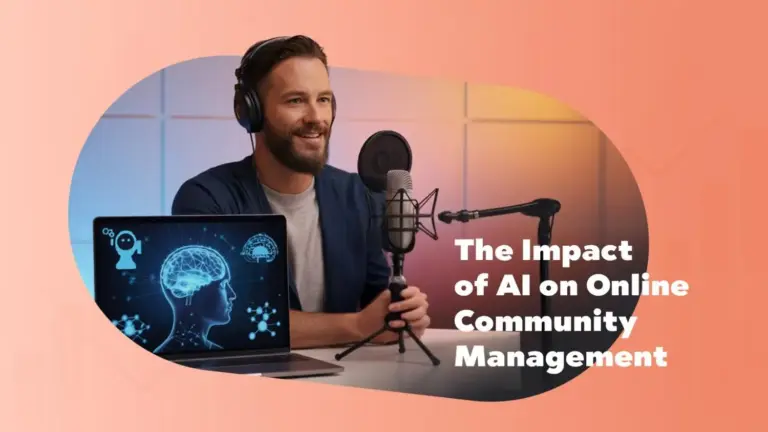Understanding the Psychology of Community Engagement
Community engagement is more than gathering people together for a shared cause. It’s about connecting individuals through shared values, emotions, and purpose. When we engage communities, we aren’t just building networks—we’re building trust, collaboration, and momentum. At its core, the psychology of community engagement explains the invisible yet powerful forces that drive people to act collectively.
In today’s hyperconnected world, where social platforms, digital forums, and global networks allow for unprecedented interactions, understanding user behaviour in communities becomes essential. People no longer engage solely based on proximity or obligation; instead, engagement stems from identity, emotion, and meaningful connection.
Why does psychology matter in community building? Because behind every tweet, post, or volunteer signup is a person with emotions, motivations, and barriers. A robust community isn’t just built with strategy—it’s cultivated with empathy and insight into how people think, feel, and act.
Take, for instance, a digital platform that encourages sustainability. Without understanding what motivates people to recycle, share content, or participate in challenges, engagement efforts will fall flat. But with a clear grasp of community engagement psychology, that same platform can create emotionally resonant campaigns, build loyalty, and inspire real-world impact.
Another great example is civic engagement platforms that allow residents to report issues in their neighbourhoods. Those that thrive typically don’t just offer utility—they offer a sense of agency and identity. When people feel their voice matters, they are far more likely to contribute. That emotional anchor is the psychological glue that turns fleeting attention into meaningful action.
In this blog, we’ll explore the depths of psychological influence on engagement—how it shapes behaviour, drives interaction, and sustains momentum. We’ll look at psychological theories, emotional triggers, barriers, and real-life strategies that turn passive observers into active participants.
So whether you’re a creator, strategist, educator, or civic planner, one truth remains: when you understand what makes people tick, you can move communities. And not just for a moment—but for the long haul.
What is Community Engagement?
Definition and Scope
Community engagement is the art and science of working collaboratively with individuals and groups—local or global, digital or physical—to address shared interests, needs, or goals. But to truly understand its depth, we need to look at how it shows up in different contexts.
Local communities often centre around geography—neighbourhoods, towns, or regions where engagement might include attending town halls, organising clean-ups, or joining parent-teacher associations. Online communities, on the other hand, transcend borders. They exist on forums, social networks, gaming platforms, and learning environments, uniting people through shared interests or goals.
Social communities often form around identities—whether cultural, political, or belief-based—while interest-based communities might gather around hobbies like photography, fitness, or gaming. Each of these community types fosters a different kind of engagement, yet they all rely on one foundational principle: connection.
Forms of engagement vary just as much:
- Events: Physical or virtual gatherings, workshops, and panels.
- Campaigns: Coordinated efforts like awareness drives, fundraisers, or advocacy pushes.
- Volunteering: Offering time, skills, or labour for a cause.
- Digital interaction: Commenting on posts, sharing content, joining webinars, and participating in discussions.
Each touchpoint presents an opportunity to participate, contribute, or take the lead. When designed well, these moments feel seamless. When designed poorly, they create friction, discouragement, and dropout.
And what connects these forms? Emotional resonance. Engagement works when it resonates with what people care about. That’s where understanding user behaviour in communities comes into play. It’s not just about offering opportunities—it’s about making those opportunities feel personally relevant.
Traditional vs. Modern Community Engagement
In the past, community engagement was tactile. It thrived on face-to-face interaction—block parties, church groups, and civic clubs. Physical presence equalled commitment. Strategies focused on in-person outreach, printed materials, and phone trees.
Today, the script has flipped. Digital engagement now leads. Social media groups, forums, video calls, and digital content allow us to build and maintain communities from anywhere. Physical presence is no longer required for emotional presence. A teenager in India can now engage in the same climate activism forum as an elder in Sweden.
With that shift, strategies had to evolve too:
- From static newsletters to dynamic social posts
- From annual meetings to real-time discussions
- From one-way messaging to two-way interaction
This shift also introduces new complexities. Digital platforms must contend with distraction, fragmented attention spans, and the psychology of instant gratification. Traditional methods built deep but slow relationships. Modern methods can build fast connections, but sustaining them requires thoughtful design.
That’s where community engagement psychology comes in. A Facebook group might have 10,000 members, but if only 50 are active, the community isn’t healthy. Numbers don’t equal engagement. Emotional investment does.
Modern engagement relies heavily on behavioural cues: How long users stay. What content do they respond to? When they drop off. These metrics aren’t just data—they’re psychological signals that help community leaders tweak and personalise engagement strategies.
In this evolving landscape, one thing stays the same: engagement begins with understanding what makes people care—and keeping them caring.
The Role of Psychology in Community Engagement
1. Human Behavior and Group Dynamics
Understanding the psychology of community engagement starts with unpacking the fundamentals of human behaviour and group dynamics. People are social beings. From the beginning of human civilisation, we’ve gravitated toward groups for survival, belonging, and identity. That basic instinct hasn’t changed. What’s changed is how we define our groups and how we engage with them.
At the heart of every community—digital or physical—is the human need to belong. Belonging is a psychological cornerstone. It provides individuals with a sense of identity, emotional safety, and purpose. When a community offers this sense of belonging, members are far more likely to invest their time, energy, and emotions into it. This emotional investment is what transforms passive observers into active participants.
Consider online communities such as subreddit forums, hobby groups, or fan pages. Their members often exhibit loyalty that mirrors that of physical-world communities. Why? These spaces satisfy the innate human desire for connection and social validation. When members share experiences, challenges, or victories, it creates a shared emotional fabric. This kind of bonding is what makes communities sticky—members don’t just log in for information, they log in for interaction and affirmation.
Another key dynamic in user behavior in communities is the need for social validation. This is why likes, shares, comments, and badges work. They’re not just vanity metrics—they’re tools of psychological reinforcement. When someone’s post gets acknowledged, it affirms their place in the group and encourages repeat behaviour. It tells them: “You matter here.”
But there’s a deeper layer. Community engagement psychology reveals that people don’t just want to belong—they want to contribute meaningfully. They want their efforts to make a difference. When communities provide opportunities for real contribution—whether that’s moderating a forum, organising an event, or simply answering questions—they unlock higher engagement levels. This is because contribution meets multiple psychological needs at once: competence, autonomy, and significance.
Psychologically, communities function best when they strike a balance between individual identity and group identity. People want to feel unique but also part of something larger than themselves. That’s where smart community design comes in—recognising individuals for their unique input while reinforcing collective values and goals.
2. Motivations Behind Participation
Let’s dig into what drives people to participate. Motivation can be broadly divided into two categories: intrinsic and extrinsic.
Intrinsic motivation comes from within. People join and engage in communities because they align with their values, interests, or passions. A person might participate in a book club because they love reading, or join a climate action group because they care deeply about the environment. This type of motivation is sustainable and emotionally grounded—it often leads to deeper, longer-term engagement.
Extrinsic motivation, on the other hand, is driven by external rewards—recognition, status, financial incentives, or social pressure. While these motivators can be effective in the short term (think referral bonuses or points-based leaderboards), they need to be used strategically. If overemphasised, they can dilute the emotional core of engagement.
The best community builders know how to blend both types of motivation. For example, a coding forum might reward top contributors with badges (extrinsic) while also fostering a culture where helping others is genuinely fulfilling (intrinsic). This mix leads to sustained participation without burnout or disengagement.
A critical piece of community engagement psychology is emotional connection. People are more likely to engage when they feel emotionally connected to the group’s purpose, values, or members. This emotional resonance turns routine interactions into meaningful experiences.
For instance, healthcare communities that support chronic illness patients often see incredibly high engagement, not because members are being rewarded, but because they find emotional support, understanding, and shared experience. That emotional safety net is priceless—and profoundly motivating.
Ultimately, effective community engagement starts with understanding what drives people. When you design spaces and experiences that align with psychological needs—belonging, validation, purpose, contribution—you create not just engagement, but genuine connection.
Psychological Theories That Influence Engagement
Understanding the psychology of community engagement isn’t just about instincts—it’s rooted in decades of research and psychological theory. These frameworks offer insight into why people behave the way they do within groups and what community leaders can do to nudge engagement forward. By anchoring strategies in these theories, you don’t just guess what works—you design with purpose.
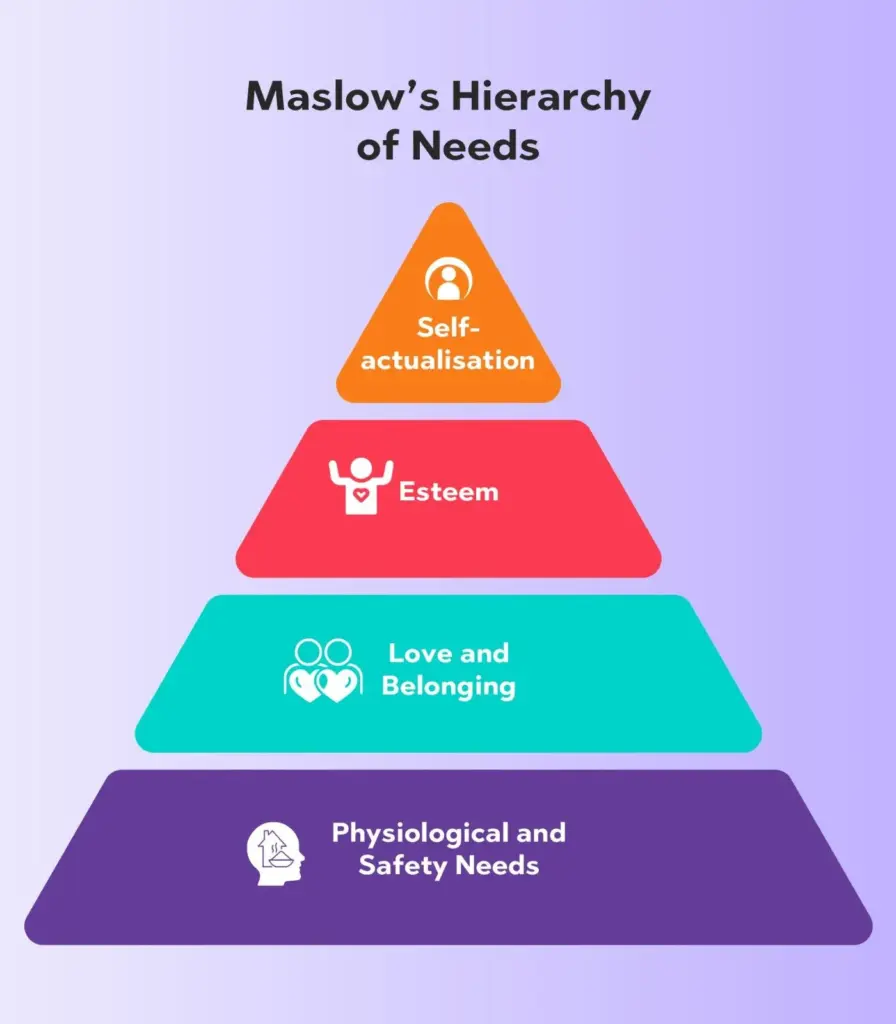
1. Maslow’s Hierarchy of Needs
Abraham Maslow’s iconic pyramid is a starting point for many psychological discussions—and for good reason. His Hierarchy of Needs outlines a five-tier model of human motivation, beginning with basic needs and ascending to self-actualisation. When applied to community engagement psychology, it provides a roadmap to meeting users where they are:
a. Physiological and Safety Needs: At the foundation, people need to feel safe and secure. In community settings, this translates to safe spaces—both physically and emotionally. Online, it might mean content moderation to prevent harassment. Offline, it could involve creating accessible, inclusive environments.
b. Love and Belonging: Communities thrive at this level. People seek out connection, friendship, and acceptance. A welcoming community with empathetic communication, storytelling, and peer validation meets these needs beautifully.
c. Esteem: Recognition fuels esteem. When members are acknowledged for their contributions—through shoutouts, badges, or leadership roles—they feel valued and competent.
d. Self-actualisation: The highest level. Communities that empower members to grow, create, and lead fulfil this need. Think of maker spaces, thought-leadership forums, or advocacy groups where members can express their fullest potential.
A successful community strategy moves people up this pyramid. From simply consuming content to contributing to leading others—that’s the engagement journey at its best.
2. Social Identity Theory
Henri Tajfel’s Social Identity Theory adds another layer. It argues that people categorise themselves and others into groups to build a sense of self. Once identified with a group, people strive to maintain its positive image, boosting self-esteem in the process.
This theory explains why members of passionate online communities defend their group fiercely. Whether it’s gamers defending their platform or activists rallying around a cause, identity drives loyalty and participation.
Community builders can harness this by fostering strong, inclusive group identities. Use rituals, shared language, symbols, and insider knowledge. These create a sense of “us” that transforms engagement from occasional to habitual.
For example, GitHub isn’t just a code repository—it’s an identity. Users call themselves developers, contribute to open source, and uphold a culture of collaboration and innovation. That identity keeps people engaged far beyond utility.
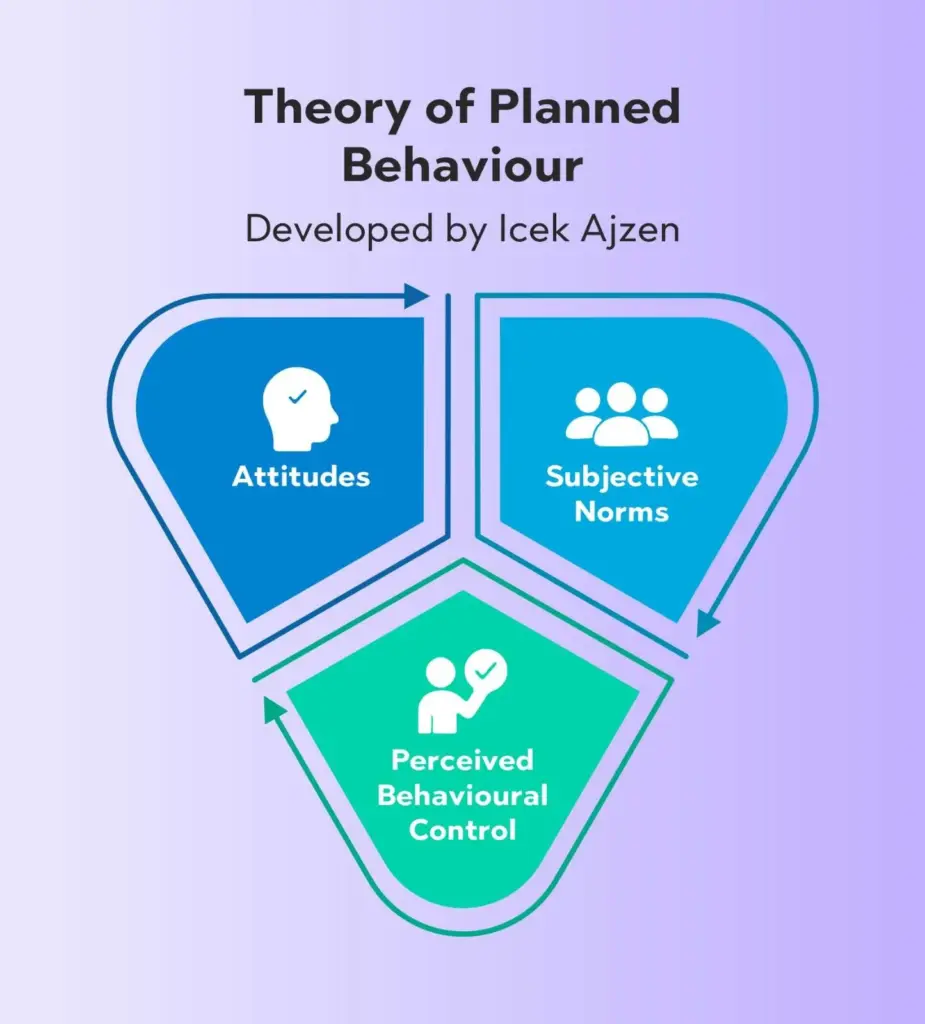
3. Theory of Planned Behaviour
Developed by Icek Ajzen, the Theory of Planned Behaviour (TPB) explains how beliefs influence actions. According to this model, behaviour is shaped by three factors:
a. Attitudes: What a person thinks about the behaviour. Is engaging in this community worthwhile?
b. Subjective Norms: What they believe others expect. Will my peers respect me for contributing?
c. Perceived Behavioural Control: Do I feel capable of taking this action?
All three must align for a person to participate. If someone believes in a cause but feels their input won’t matter—or lacks the tools to participate—they’ll stay on the sidelines.
Communities can influence all three. Want to change attitudes? Use storytelling and success stories. Want to shape norms? Celebrate active users and model participation. Want to boost perceived control? Offer tutorials, easy onboarding, and low-stakes ways to get involved.
For instance, Duolingo doesn’t just teach language—it creates a behaviour loop grounded in TPB. Daily reminders (attitude), visible leaderboards (norms), and micro-goals (control) all work together to sustain engagement.
Emotional Triggers and Community Response
Communities are emotional ecosystems. While strategy, content, and design matter, it’s the emotional undercurrents that determine whether people engage deeply or drift away. Understanding the psychology of community engagement means understanding emotional triggers and how they influence participation, trust, and loyalty.
1. Empathy and Shared Experiences
Empathy is the foundation of connection. When people feel seen, heard, and understood, they’re more likely to engage—and keep coming back. Empathy humanises community spaces. It transforms them from transactional to transformational.
Communities that invite storytelling and shared experiences activate emotional resonance. Storytelling isn’t fluff—it’s neuroscience. When someone shares a personal story, it activates mirror neurons in the listener’s brain, helping them emotionally “relive” the experience. This creates a powerful emotional bond between storyteller and audience.
Consider support groups for grief, chronic illness, or trauma. These aren’t just informational hubs. They’re emotional sanctuaries. Members return because they find people who “get it”—who’ve walked similar paths. That shared experience makes the community irreplaceable.
Even in professional or hobbyist spaces, shared experiences matter. A UX design community might rally around frustrating client stories. A parenting group bonds over midnight meltdowns. These moments of “me too” generate the empathy that sustains engagement.
To foster this, community leaders should:
- Prompt open-ended conversations.
- Highlight user journeys.
- Normalise vulnerability.
- Encourage peer-to-peer support.
Communities rooted in empathy create safety, and safety breeds participation.
2. Trust and Authenticity
Trust is the currency of engagement. Without it, people lurk. With it, they contribute.
Psychologically, trust lowers the perceived risk of participation. People are more likely to share, comment, or volunteer when they believe the space is safe and their input is respected. But trust isn’t declared—it’s earned, over time, through consistent, transparent behaviour.
Authenticity plays a critical role here. In an age of curated personas and corporate messaging, authenticity feels refreshing—and rare. When community managers, leaders, or moderators communicate with honesty and vulnerability, it humanises the brand or organisation behind the community.
Consider these trust-building behaviours:
- Admit mistakes and explain how you’ll fix them.
- Highlight behind-the-scenes challenges, not just wins.
- Celebrate diverse voices, even those that disagree respectfully.
- Respond promptly and transparently to issues or feedback.
Look at Reddit’s AMAs (“Ask Me Anything”)—they succeed when public figures show up authentically, answer tough questions, and speak like humans. The moment a community senses inauthenticity—over-polished messaging, ignored feedback, favouritism—trust erodes, and with it, engagement.
Another aspect of trust is consistency. People feel secure when expectations match reality. If a community promises weekly updates or open moderation, it must deliver. Every broken promise chips away at the emotional contract between members and the group.
But when trust and authenticity are high, communities flourish. Members invite others, invest more time, and defend the space against toxicity. That’s not just behavior—that’s belonging.
Emotions are powerful. They’re often the silent drivers behind every click, comment, and contribution. Community engagement psychology teaches us that when we tap into empathy, foster shared experiences, and lead with authenticity, we don’t just build activity—we build loyalty.
Barriers to Community Engagement
Even the most vibrant communities face resistance. Engagement isn’t always about adding more—it’s often about removing what’s in the way. To truly understand user behavior in communities, we must identify and address the psychological and structural barriers that keep people from participating. These obstacles are often subtle, invisible to analytics but glaringly obvious in the lived experience of potential members.
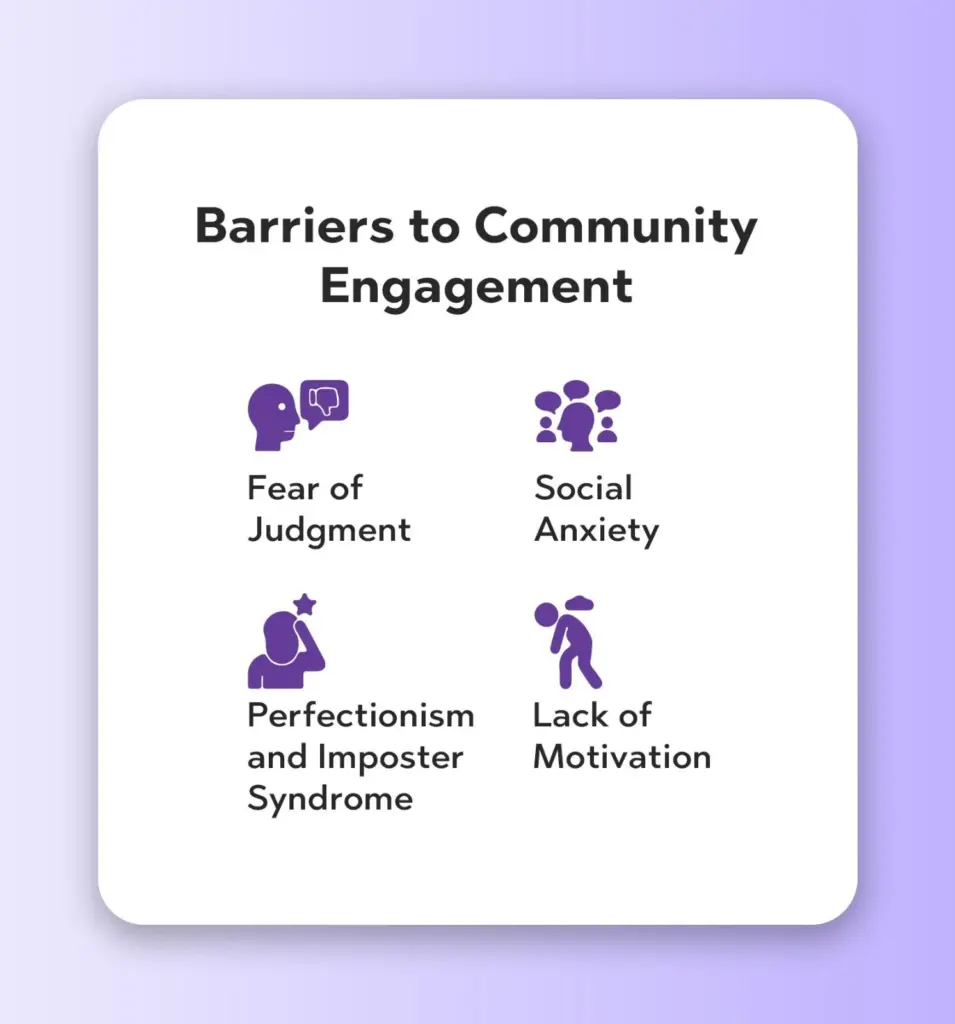
1. Psychological Resistance
Psychological resistance is the internal friction that holds someone back from engaging, even when they’re interested. It stems from fear, doubt, or emotional discomfort. Here are the most common types:
- Fear of Judgment: People worry that their opinion won’t be good enough or will be criticized. In digital spaces, this fear is amplified. A new user might hesitate to comment on a thread with seasoned members, fearing they’ll be dismissed or ridiculed. This fear inhibits participation and stalls organic conversation.
- Social Anxiety: Some users find interaction draining, especially in communities where communication is public or performance-based. Livestream events, group video calls, or active comment threads can feel overwhelming. Even well-intentioned formats can accidentally alienate quieter members.
- Perfectionism and Imposter Syndrome: These are common among creators, experts, and professionals. Members may lurk for months because they feel they have “nothing valuable to contribute” or fear saying something wrong. That internal narrative kills momentum before it begins.
- Lack of Motivation: Engagement requires energy. Without emotional buy-in, people disengage. This often happens in communities that focus only on information but neglect inspiration or interpersonal connection.
The psychology of community engagement helps tackle these issues head-on. Solutions include:
- Low-pressure entry points (like anonymous posts or intro threads)
- Moderated safe spaces for newbies
- Affirming responses from community leaders
- Highlighting a wide range of voices, not just the loudest
Reducing psychological friction makes engagement more accessible and welcoming.
2. Structural and Social Barriers
While internal resistance is powerful, external barriers can be just as limiting, sometimes even more so. These include:
- Digital Divide: Not everyone has equal access to fast internet, modern devices, or user-friendly platforms. Communities built with tech-first assumptions risk excluding those in rural areas, older age groups, or lower-income brackets.
- Representation Gaps: People engage where they feel represented. If community visuals, leadership, or language reflect only one demographic, others may feel out of place. Diversity isn’t just ethical—it’s strategic. A community that feels monocultural alienates more than it welcomes.
- Inaccessible Design: Poor UX, complex onboarding, or lack of accessibility features (like screen reader compatibility or captioned videos) creates friction. Communities must be inclusive by design, not as an afterthought.
- Time Zones and Life Stages: Global or mixed-age communities must consider timing and flexibility. A single live session may work for some but not others. Asynchronous engagement options—forums, recorded sessions, or on-demand content—help overcome this.
- Toxic Culture or Gatekeeping: Even the most mission-driven communities can become hostile if a few dominant voices are left unchecked. Harassment, cliques, or elitism create invisible fences that keep others out. Left unresolved, these issues poison engagement.
Removing these structural barriers starts with empathy. Talk to your members. Audit the experience through different lenses—newcomers, marginalized users, disabled members, and time-poor professionals. Community engagement psychology emphasises perspective-taking as a tool for growth.
Some actionable fixes:
- Create multilingual content or translation support.
- Appoint diverse moderators with lived experience across different backgrounds.
- Offer clear “getting started” guides and visual navigation aids.
- Use inclusive language and imagery across all content.
Removing barriers is just as important as adding value. When we dismantle what excludes, we amplify what includes. Communities flourish not when everyone fits the mold, but when everyone feels the mold was built for them.
Strategies to Improve Community Engagement Using Psychology
Designing community engagement strategies without psychological insight is like building a house without a blueprint. You might end up with a structure, but it won’t be stable or inviting. The psychology of community engagement provides that blueprint. It helps you understand what makes people show up, speak up, and stay involved. Now let’s look at practical, psychology-backed strategies that move the needle.
1. Personalization and Inclusivity
We’re in the age of personalisation. People expect experiences that speak directly to them, not as part of a crowd, but as unique individuals. When communities reflect members’ identities, values, and preferences, engagement becomes personal. And personal engagement is powerful.
Start by tailoring experiences to the needs and expectations of different audience segments. This could mean:
- Personalized content recommendations based on interaction history
- Welcoming emails that refer to the user’s specific interests or onboarding choices
- Segmenting newsletters based on location, activity level, or roles within the community
Inclusivity goes hand-in-hand with personalisation. The more diverse, inclusive, and affirming your community is, the more accessible and engaging it becomes. That includes:
- Highlighting stories from under-represented voices
- Using inclusive language across posts and campaigns
- Being culturally aware during events and campaigns
Inclusivity signals psychological safety—a core principle of community engagement psychology. People engage when they feel safe to be themselves, without judgment or exclusion.
2. Gamification and Reward Systems
Gamification isn’t just a gimmick—it’s neuroscience. When done right, it taps directly into the brain’s reward system. Every point earned, badge unlocked, or leaderboard climbed gives the brain a hit of dopamine. This encourages repeat behaviour and helps form habits.
Here’s how to use gamification without making it feel like a game:
- Progressive Challenges: Start small and increase difficulty. Let members “level up” in ways that reflect real growth.
- Micro-Rewards: Celebrate small actions like first posts, profile completions, or peer replies.
- Visible Recognition: Leaderboards, badges, and top-contributor lists—when done right—fuel healthy competition and pride.
But beware: over-reliance on external rewards can weaken intrinsic motivation. Balance is key. Use gamification to start the habit loop—but deepen the engagement with purpose and connection.
Psychologically, gamification also taps into autonomy (users choose how to engage), mastery (they see improvement), and purpose (they feel part of something bigger).
Think of Duolingo, Fitbit, or Stack Overflow—they’ve mastered gamification by making small wins feel like big achievements while tying them into meaningful outcomes.
3. Feedback Loops and Recognition
Nothing kills engagement faster than silence. When someone contributes to a community and hears nothing in return, they feel invisible. Feedback is the heartbeat of engagement. It tells members, “You matter. We see you.”
There are three critical types of feedback loops:
- Immediate Acknowledgement: Quick reactions like likes, emojis, and comments.
- Social Recognition: Shoutouts in newsletters, mentions during live events, or featured user stories.
- Constructive Reflection: When ideas are implemented, tell members how their input made an impact.
Recognition isn’t just about stroking egos—it fulfils deep psychological needs for esteem and belonging. When people see their contributions shaping the community, they transition from consumers to co-creators.
Another underused tool is ritualised recognition. Weekly wins, member of the month, or anniversary shoutouts create recurring moments of joy and connection.
Also consider private feedback loops: automated thank-you messages, personalised progress updates, or moderator DMs after a great contribution. These small touches build immense goodwill.
The key? Make recognition authentic. Forced or formulaic praise feels hollow. But real, thoughtful acknowledgement? It’s engagement gold.
By embedding psychological principles into your strategy—from personalisation to gamification to recognition—you don’t just build a community. You build belonging. And when people feel they belong, they show up again and again—not because they have to, but because they want to.
Case Study
Digital Campaign — Plastic-Free Challenge App
The challenge: A sustainability startup wanted to reduce single-use plastic consumption. Their first approach—educational content and product alternatives—got clicks, but engagement was shallow. People read posts but don’t take action.
The pivot: They studied user behaviour in communities and decided to launch a behavioural science-backed mobile app: The Plastic-Free Challenge.
How it worked:
- Users joined 30-day challenges with small daily tasks.
- They earned points, badges, and level-ups for completing tasks like refusing straws, bringing tote bags, or logging plastic-free purchases.
- The app included community features: users could post tips, celebrate streaks, and share progress.
- Every week, top contributors were featured in social media shoutouts and in-app banners.
- Feedback loops were instant. Completed a task? You’d get a dopamine-spiking animation and a “well done” message. Dropped a streak? The app sent you a gentle reminder, not guilt-tripping, but encouraging.
The psychology at play: gamification (dopamine, habit formation), social validation (peer feedback), and intrinsic motivation (purpose-driven behaviour).
The outcome: In 60 days, engagement tripled. Retention increased by 45%. Most importantly, the average user reduced their plastic use by 40% during the challenge. Many continued the habits afterward.
Why it worked: The app didn’t just give users information—it gave them identity. Users saw themselves as change-makers, eco-leaders, role models. That shift from consumer to contributor is the heart of effective community engagement.
Future of Community Engagement and Behavioural Science
The future of community engagement is evolving at lightning speed. What once relied on bulletin boards and in-person meetups is now driven by data dashboards, predictive algorithms, and neuroscience-backed strategies. But this evolution doesn’t mean leaving human psychology behind—in fact, it means leaning into it even more deeply.
As we move forward, the psychology of community engagement will become even more essential, not less. Why? Because the more digital our interactions become, the more intentional we need to be about designing for connection, trust, and meaning.
The Role of AI, Data, and Behavioural Science
Artificial intelligence and data analytics are already changing how we understand user behaviour in communities. AI can analyse engagement patterns in real time, identifying drop-off points, high-interest topics, and even emotional tone based on language used in comments or posts.
Here’s what that unlocks:
- Personalised Content Delivery: AI can tailor content to individual members based on behaviour, engagement history, or even inferred emotional states. Someone who reads but never comments might receive a gentle nudge. A superuser might be invited to moderate or co-create.
- Sentiment Analysis: Natural language processing can scan community conversations and surface trends in mood—are members frustrated, inspired, or confused? This real-time pulse check allows for quicker interventions and more adaptive leadership.
- Behaviour Prediction: With enough behavioural data, AI can anticipate what members are likely to do next, such as drop off after onboarding or re-engage during certain campaigns. Community managers can use this insight to intervene proactively, rather than reactively.
But data without context is just noise. Behavioural science provides the meaning behind the numbers. It helps interpret why people behave the way they do, how habits form, and what emotional or cognitive triggers are at play.
By blending AI and behavioural psychology, future communities won’t just be responsive—they’ll be anticipatory. That’s a game-changer.
Neuropsychology and the Science of Attention
One of the next big frontiers is neuropsychology—the study of how the brain responds to stimuli and what that means for digital engagement.
In an age of information overload, understanding attention is gold. Neuroscience tells us that the brain filters out repetitive or non-rewarding experiences quickly. So communities that don’t offer novelty, emotional payoff, or social value get ignored.
This insight will shape the future of content and design. Expect to see:
- Dynamic design systems that adapt based on user engagement levels.
- Emotionally intelligent bots that respond empathetically, not just functionally.
- Micro-moment optimisation, where even tiny interactions (like confirming attendance or clicking “like”) are intentionally crafted for psychological payoff.
Attention is the new currency. And to earn it, community builders must understand how brains work, not just interfaces.
Predictive Behavior Models in Civic and Social Planning
Beyond tech platforms, community engagement psychology is being embraced in civic design and urban planning. Cities are now using behavioural models to:
- Predict public response to policies or events
- Design better public engagement tools (like participatory budgeting platforms)
- Encourage civic behaviors like voting, recycling, or public health compliance
For example, some municipalities use predictive modelling to identify which neighbourhoods are most likely to benefit from community outreach and tailor their strategies accordingly. It’s behavioural science applied at the policy level.
This trend will only grow. As communities become more complex and diverse, understanding human behaviour will be essential for designing inclusive, equitable, and effective public systems.
The future of community engagement isn’t about removing the human element—it’s about understanding it better. Whether through AI, neuroscience, or predictive modelling, the goal remains the same: creating spaces where people feel seen, valued, and motivated to connect.
Conclusion
Community engagement isn’t just a marketing metric or social initiative—it’s a human endeavour. At its core, it’s about emotion, identity, and connection. And if there’s one lesson the psychology of community engagement has taught us, it’s this: people don’t act unless they feel something.
Across every section of this journey—from defining what community engagement truly means, to exploring group dynamics, behavioural theories, emotional triggers, and barriers—we’ve uncovered one unifying truth: understanding user behaviour in communities is the key to building spaces that thrive.
Let’s recap the key insights:
- People engage when they feel they belong. Whether it’s a shared story or a mutual goal, community starts with connection.
- Psychological safety and trust are foundational. Without them, even the most well-funded communities will struggle to grow.
- Motivation is multifaceted. Engagement is sustained when both intrinsic (purpose, passion) and extrinsic (rewards, recognition) motivators are in play.
- Emotion drives participation. Empathy, pride, excitement, even frustration—all these emotions fuel action when harnessed wisely.
- Barriers must be dismantled. Inclusion, accessibility, and authenticity aren’t add-ons—they’re the ground rules.
- Science and strategy must co-exist. When you apply theories like Maslow’s Hierarchy or Social Identity Theory to real-world engagement, you stop guessing and start designing for success.
As we look to the future—driven by AI, predictive behaviour models, and neuropsychology—the challenge will be to humanise, not mechanise, our engagement. Automation should never replace emotion. Technology should enhance, not erase, the heart of human connection.
For organisations, creators, and leaders, this means rethinking how you measure success. Don’t just track clicks or attendance. Ask:
- Are we making people feel seen?
- Are we building trust, not just traffic?
- Are our members growing in identity, agency, and purpose?
Because when you nurture those things, engagement isn’t temporary—it’s transformational.
Final Thoughts on Ethical and Sustainable Engagement
There’s one more element we must not ignore: ethics. Using psychology to drive engagement carries responsibility. Emotional triggers can be used to inspire or manipulate. Behavioural nudges can build habits—or exploit them. Trust can be earned—or gamed.
Sustainable community engagement means honouring the dignity of every member. It means prioritising long-term well-being over short-term metrics. It means designing communities that elevate, not exhaust, the people within them.
The best communities don’t just gather people. They grow them.
They don’t just broadcast messages. They build movements.
They don’t just engage—they empower.
FAQs
The psychology of community engagement is the study of how human emotions, motivations, behaviours, and social influences drive people to connect, participate, and contribute within communities. It looks at what inspires individuals to become active members, what sustains their involvement, and what causes them to disengage. It draws on principles from behavioural science, cognitive psychology, social psychology, and neuroscience to explain everything from group loyalty to participation rates.
People engage in communities to fulfil deep psychological needs, such as belonging, identity, validation, and purpose. For some, it’s about sharing experiences or receiving support. For others, it’s about contributing to a cause or gaining social capital. These motivations are often a blend of intrinsic (personal satisfaction, values) and extrinsic (recognition, rewards) factors. Communities that align with a person’s sense of self and provide emotional connection are far more likely to see sustained participation.
According to Social Identity Theory, people define themselves by the groups they belong to. This sense of identity influences how they behave, what they support, and how they engage. When individuals strongly identify with a group, they’re more likely to contribute, defend it from criticism, and follow group norms. Strong community brands, shared rituals, and insider language reinforce this identity, deepening loyalty and participation.
Key emotional drivers include empathy, pride, trust, curiosity, and even frustration (which can lead to activism). Communities that allow members to express themselves, feel validated, and experience emotional resonance through storytelling, recognition, or support encourage more profound involvement. On the flip side, negative emotional environments (e.g., toxic discussions, exclusion) push people away.
Some of the most common psychological barriers include:
Fear of judgment or rejection
Social anxiety or introversion
Imposter syndrome or perfectionism
Lack of emotional safety or psychological trust
Overwhelm or decision fatigue
Understanding and removing these barriers—through inclusive design, beginner-friendly pathways, and empathetic moderation—is key to improving participation.
Organisations can use behavioural science to:
Identify what motivates their audience
Design reward systems that encourage action
Use nudges and triggers at key engagement moments
Create emotionally compelling experiences
Personalize content and feedback
Monitor user behavior for real-time insight
For example, using social proof (“85% of members completed this challenge”) leverages peer influence, while progress bars and gamification support habit-building.
Empathy is foundational. It allows community leaders to understand and meet the emotional needs of their members. Empathetic communities create spaces where people feel safe, valued, and heard. This emotional security encourages vulnerability, trust, and collaboration—all of which lead to higher engagement. Empathy also drives more inclusive policies and human-centred design.
Yes—when used responsibly. Gamification taps into reward-based learning, habit loops, and competitive spirit. By using points, badges, leaderboards, and streaks, communities can make engagement fun and addictive. But gamification must align with meaningful outcomes and be carefully balanced with intrinsic motivators to avoid shallow or burnout-driven participation.
Recognition validates contributions. It satisfies the human need for esteem and reinforces positive behaviour. When members are acknowledged—publicly or privately—they feel seen. This boosts their emotional investment and increases the likelihood of continued participation. Whether it’s a shoutout, badge, or thank-you note, recognition tells members: “You matter.”
Storytelling circles that tap into emotional resonance and shared identity.
Challenge-based apps that use gamification to change habits.
Recognition boards and public appreciation posts to reinforce esteem.
Personalized onboarding journeys that lower the activation barrier for new members.
Moderated safe spaces for vulnerable discussions.
Each of these examples applies a principle from psychology—such as identity, feedback, or emotional safety—to build stronger, more engaging communities.
